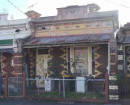Back to search results
COSGROVE DOMESTIC ARTEFACT SCATTER
45 SUTHERLAND ROAD COSGROVE, GREATER SHEPPARTON CITY
COSGROVE DOMESTIC ARTEFACT SCATTER
45 SUTHERLAND ROAD COSGROVE, GREATER SHEPPARTON CITY
All information on this page is maintained by Heritage Victoria.
Click below for their website and contact details.
Victorian Heritage Inventory
-
Add to tour
You must log in to do that.
-
Share
-
Shortlist place
You must log in to do that.
- Download report
On this page:
Statement of Significance
This record has minimal details. Please look to the right-hand-side bar for any further details about this record.
Show more
Show less
-
-
COSGROVE DOMESTIC ARTEFACT SCATTER - History
There is a long history of agricultural use of the activity area, including initially sheep, cattle and horse grazing followed by dryland cropping. The history of the activity area is predominantly associated with the history of settlement and agricultural development, which demonstrates a general trend from large to small holdings with the rise of irrigation agriculture.
The activity area once formed part of the Benalla and Pine Lodge runs comprising 75 square miles and 43,850 acres respectively. Pine lodge was formed in January 1858 as a sub-division of the larger Arcadia run. Benalla run was gazetted in July 1848. The license of Pine lodge was forfeited in 1878 and Benalla's license was eventually forfeited in 1882.
By the 1880s, vast changes had occurred in the landscape due to the introduction of cereals and weeds, livestock, fishing and timber industries. Sheep, cattle and horse grazing had increased due to closer settlement policies instigated by the government and Curr who had settled the Tongala and Lower Moira runs forty years prior noted the profound effect that trampling from livestock had on drainage in the landscape. He claims it hardened the ground, thereby increasing surface water runoff. Trampling by livestock also made the beds of creeks more impervious and in conjunction with flattening of river and creek banks led to more extensive and frequent flooding than in the past.
The introduction of sawmills to the region resulted in vast quantities of trees being cleared not only from the Moira and Barmah forests but the surrounding countryside as well. Clearing of trees from the landscape was followed by ploughing and cropping, which resulted in destabilised soils. In 1914, the worst drought on record hit the region. Crops failed, grass withered, dams dried, the ground cracked and vast dust storms raged across the landscape.
The Goulburn Irrigation System was implemented following the establishment of the first Irrigation Trusts during the 1880s. In the region, the Goulburn Irrigation System focussed around the Broken River to the south of the current study area.
The government promoted land settlement in the region based on irrigation development. This provided the government with an opportunity to implement rural Settlement Policies, such as Soldier Settlement Schemes. Nearby Katandra formed one of these Soldier Settlement Schemes. This scheme was introduced in 1927, coinciding with the extension into the area of the East Goulburn Irrigation Scheme as represented by the East Goulburn Channel, which is on the western border of the Cosgrove Irrigation District.Heritage Inventory Description
COSGROVE DOMESTIC ARTEFACT SCATTER - Heritage Inventory Description
Site contains visible assorted glass bottles and ceramic material.
-
-
-
-
-
COSGROVE DOMESTIC ARTEFACT SCATTER
 Victorian Heritage Inventory
Victorian Heritage Inventory
-
-






